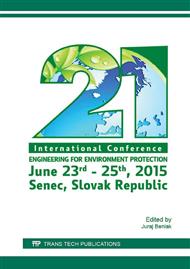p.177
p.184
p.192
p.200
p.207
p.213
p.218
p.224
p.231
Optimization of Secondary Air Distribution in Biomass Boiler by CFD Analysis
Abstract:
This paper deals with a use of CFD modelling for optimization of supply of secondary combustion air in the two-chamber biomass boiler combusting very wet biomass (capacity ca. 200 kW). Objective of the analyse is to observe the impact of diameter of a secondary air supply pipe and air flow velocity on mixing of the secondary air with flue gas in the combustion chamber. The numerical model of the experimental boiler was build up for subsequent utilizing of CFD computation based on finite element method. The commercial code STAR-CD was used for carried out parametrical studies. Series of calculations were carried out for four different diameters of air distribution pipes and for 3 different air velocities in distribution orifice. Quality of air dispersion in flue gas flow was assessed in the vertical cross section lead in the end of the combustion chamber. The results of calculation were verified on the experimental installation of the boiler. Influence of secondary air mixing on emission production was measured and analysed. Emissions of pollutants for recommended air distribution comply with emission limits stipulated in the most stringent class 5 according to ČSN-EN 303-5 as well as with emission limits under Regulation No. 405/2012 Sb.
Info:
Periodical:
Pages:
231-237
Citation:
Online since:
April 2016
Authors:
Keywords:
Price:
Сopyright:
© 2016 Trans Tech Publications Ltd. All Rights Reserved
Share:
Citation:


